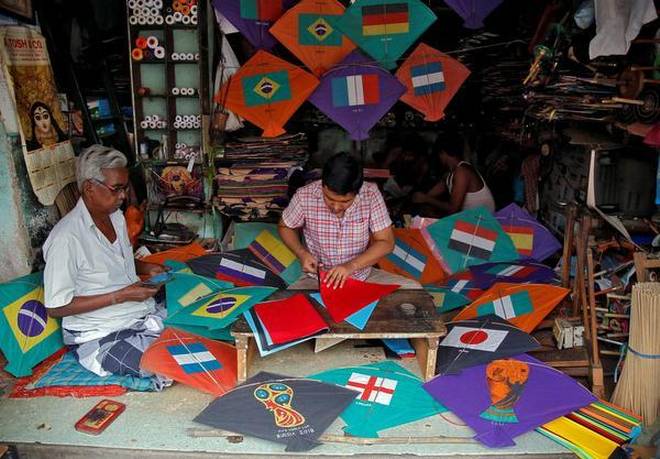Festivals in India mean much more than just the joy of celebrations. It is also a time when employment and income generation peaks for those not only hailing from the small and medium enterprises background, but also individuals and those who belong to the unorganised sector.
Small businesses, large benefits
For instance, a month before the festival of Raksha Bandhan, Shubha Chakravarthy, a widow from Hooghly district makes weekly trips to the Bura Bazaar market in Howrah to purchase threads, beads, and other decorative material for making ‘rakhis’ (an amulet that is tied by a sister on her brother`s wrist on the day of the festival of ‘Raksha Bandhan’). She then assembles the material to make wonderful wrist bands or rakhis, and sells them by weight in her hometown of Kalna in remote rural Bengal, to local customers, housewives and even general stores.
For Shubha, the pension of her late husband, a local panchyat member, hardly covers the tuition fees of her teenage daughter, but the extra income generated from the sale of rakhis during Raksha Bandhan helps in making their lives a bit more comfortable.
After Raksha Bandhan, Shubha engages herself in another income generating activity that Durga Puja festival brings. She makes trips to handloom weavers in the neighbouring villages of interior Bengal to source cotton saris, and sells them at the local stalls in her village during the Durga Puja, hiking their price a little to cover her profits that include the efforts she has taken to source them.
Like Shubha, there are many others who use their skills for earning extra income during festivals.
Idol making is another seasonal activity that helps artisans augment their income. For the many idol makers of West Bengal and Maharashtra, the beginning of Durga Pujo season and Ganesh Chaturthi not only brings joy in their lives, but also prosperity because of the work and money the festival season brings. These artisans create beautiful idols of Gods and Goddesses which are thematic ,and come in various sizes. The process of making idols begins a couple of months before the festival. Idols of Durga and Kali created by these artisans are shipped off to the many pandals around the country and even to devotees abroad, generating a good amount of money for the idol makers. Similarly Ganesh idols too are transported to near and far off places. Along with the idol makers, the decorators of pandals, where the idols are installed, too get busy around this time, and some even migrate to other states in the country to set up elaborate and eye catching pandals that enhance the beauty of the idols. The costs of many of these pandals can run into a few lakhs, even crores.
It is brisk business for flower vendors too, as the demand for flowers and garlands made from flowers peaks during the festival season. A variety of fresh grown in different parts of the country flood the flower markets in the cities. Making ‘torans’ and garlands need special skills and speed, and many families are engaged in the business of making bouquets, torans and garlands. These flower garlands are not only offered to the deities, but used in decorating pandals and homes. As only fresh flowers are offered to God, each day is good business for the vendors during the festive season.
Makar Sankranti is yet another festival that kite makers in India look forward to in the month of January. The kite festival is celebrated in various states of India on this day, where the young and old participate. Simple and fancy kites in different shapes, sizes and colours are seen floating in the skies on this day, and people compete in kite-flying. The international kite flying competition is held in Ahmedabad, Gujarat, and attracts not only local kite-flyers, but experts from all over the world. Months before the festival, homes in Gujarat begin to manufacture kites which are then sold to local vendors or directly to kite flyers, by setting up small shops in their homes. Jamalpur, a small area in the old city of Ahmedabad is considered as the hub of kite making, and is the largest kite market in India. The festival has immensely benefited the kite manufactures in Gujarat. Nowadays, kite flying is held in other states too, generating employment in the unorgansied sector in those states.
Diwali is a festival of lights, and traditionally celebrated by lighting diyas or traditional lamps made of mud, clay and terracotta. Although colourful electric bulbs from China and machine-made decorative lamps have flooded the markets in cities, there is still a big market for the traditional diyas.
Generating business for locals
A large part of India’s manufacturing is largely dependent on the unorganised sector which is scattered all over the country or run by small societies/unions or Self-Help Groups (SHG).
With day jobs to survive, these groups are known to come alive during the festive season. Nirmala, an ‘anganwadi’ worker gets transformed into a full time chef close to the Diwali festival. She, along with her team is engaged in making delicacies for Diwali, catering to a large clientele of working women who do not have the luxury of time to prepare Diwali sweets at home. Nirmala confides that the festival time is when she and her circle of women in her SHG or Bachat Gat (as called in Marathi), are able to make a good amount of money to survive through the year.
Each year close to festivals such as Ganesh Chaturthi, Durga Puja, Kali Puja, Navaratri, Diwali, Christmas, etc., across India SHGs of every kind come alive luring consumers with a wide variety of crafts and food. Festivities not only brings in joy and excitement to those celebrating them but also to a whole lot of others involved in the manufacturing and production of goods for local consumption.
Festivals — a means of survival for the common man
The range of smaller businesses that spring to life during the festive seasons too end up being a part of the nation’s financial ecosystem in some way or the other. Unlike the Western or European countries where emphasis on solidifying local businesses is part of their financial and social fabric, in India, we still have a long way to go in terms of bringing them into a recognised space.
Like Shubha there are many women and men across the country who form a crucial part of the country’s economic backbone. It is time that not only the government, but we too as a society recognise their contribution, and help in drafting policies that work in favour of bringing them into the visible zone.


 [/column]
[/column]